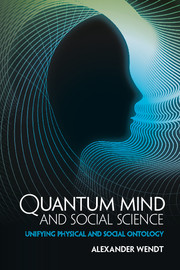Book contents
- Frontmatter
- Dedication
- Epigraph
- Contents
- Acknowledgments
- 1 Preface to a quantum social science
- Part I Quantum theory and its interpretation
- Part II Quantum consciousness and life
- Part III A quantum model of man
- Part IV Language, light, and other minds
- Part V The agent-structure problem redux
- Conclusion
- Bibliography
- Index
Part I - Quantum theory and its interpretation
Published online by Cambridge University Press: 05 May 2015
- Frontmatter
- Dedication
- Epigraph
- Contents
- Acknowledgments
- 1 Preface to a quantum social science
- Part I Quantum theory and its interpretation
- Part II Quantum consciousness and life
- Part III A quantum model of man
- Part IV Language, light, and other minds
- Part V The agent-structure problem redux
- Conclusion
- Bibliography
- Index
Summary
Introduction
Chapter 1 dealt with one of the deepest mysteries in modern science: how to explain consciousness. This Part deals with another mystery: how to make sense of quantum mechanics. Both involve a problem of reconciliation with the classical worldview, which is one hint that the two mysteries might be related. A second is that, unlike classical physics, which makes no reference to or allowance for consciousness, quantum theory raises the issue of consciousness and its relationship to the physical world in a very direct way. These hints do not necessarily mean there is a connection between the two mysteries, but by the end of this Part I hope to have shown why it would be natural to look for one.
My more immediate aim here is to give the social scientific reader an introductory understanding of the experimental findings of quantum theory, its key concepts, and the debates about its interpretation. The discussion assumes no prior knowledge of quantum physics and makes no use of mathematics. Quantum theory without equations might seem like an oxymoron, and certainly reading this Part will not enable anyone to use quantum theory. But to a perhaps surprising degree it is possible to understand quantum theory without being able to use it. Its findings can be communicated in ordinary language, and the same goes for its main concepts and interpretive debates. One consequence of this has been the emergence of a virtual cottage industry of books on quantum theory for a lay audience. Most are written by physicists, and many are quite good. However, it is not just popular treatments that do without equations: much of the professional philosophical literature does as well. (I draw on both kinds of literature below.) Philosophers of physics are trained to understand the math, of course, which is necessary for a full appreciation of the issues.
Information
- Type
- Chapter
- Information
- Quantum Mind and Social ScienceUnifying Physical and Social Ontology, pp. 39 - 42Publisher: Cambridge University PressPrint publication year: 2015
